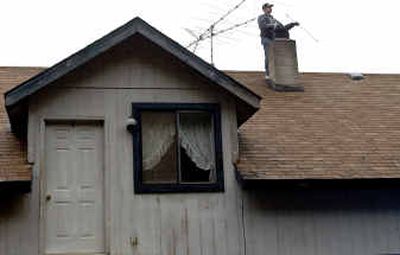Fireman Joe solves chimney problems

Polly Schindler doesn’t like to watch when her husband Joe, owner of Fireman Joe’s Chimney Sweep, does his thing.
“I watched him do one sweep. I won’t do it again. He was like Spider-Man without the web. Ignorance is bliss,” she said.
In 12 years of sweeping chimneys, Schindler has fallen off a roof only once. He fell from the second story of a house, 25 feet.
“His footprints were still in the ground the next year,” Polly said. When Schindler went to sweep the homeowner’s chimney the following year, the homeowner pointed out the place of impact.
Schindler of Coeur d’Alene is accustomed to risky business. Besides sweeping chimneys, he works full time as a firefighter, an engineer, with the Spokane Valley Fire Department. He’s been with the department 13 years and before that was a firefighter in the Air Force, stationed at Fairchild Air Force Base. He was inspired to go into firefighting after several Spokane-area homes were burned in the 1991 firestorm.
A friend introduced him to chimney sweeping. “I helped him out. Then I figured I could do it myself,” Schindler said.
He likes meeting people and enjoys “getting out and solving problems they have with their chimneys. Making it a safer environment.”
“It’s an inherently dangerous thing to put a fire in a house in a box,” Schindler said.
A chimney that has a buildup of creosote, a byproduct of combustion, and needs to be swept, can cause smoke in the house, may not draw properly and may spark a chimney fire. Most of the time homeowners aren’t even aware they’ve had a chimney fire, he said.
Burning green wood or not allowing the fire to get hot enough to burn off the creosote can allow creosote to build up. “I usually let (wood) sit for a year before I burn it,” he said. He recommends that people buy their wood in the spring and let it sit over the summer.
It isn’t always creosote that blocks the chimney. Once, Schindler found a dead duck stuck in a chimney. He also finds bird nests, beehives, chipmunks, squirrels and bats.
Besides sweeping chimneys, he replaces cracked chimney liners. A cracked chimney liner can allow carbon monoxide into the house or result in a chimney fire.
“My job is to do an inspection of the system. Is it safe? Does it need to be swept?”
Sometimes a chimney can go for three years before it needs to be swept. Sometimes he’s had to sweep the same chimney three times in a year. He recommends, however, that homeowners have their chimneys inspected once a year.
His wife serves as his secretary, scheduling appointments in North Idaho and as far away at St. Maries, Spirit Lake and the Silver Valley. In a typical season, he might service 150 homes. Fall is the busiest time of year.
The hardest part is getting people to get their chimneys swept in the spring or summer.
“It’s safer to get on the roof, and I have more time,” he said. “But they don’t think about chimneys in the summer.”